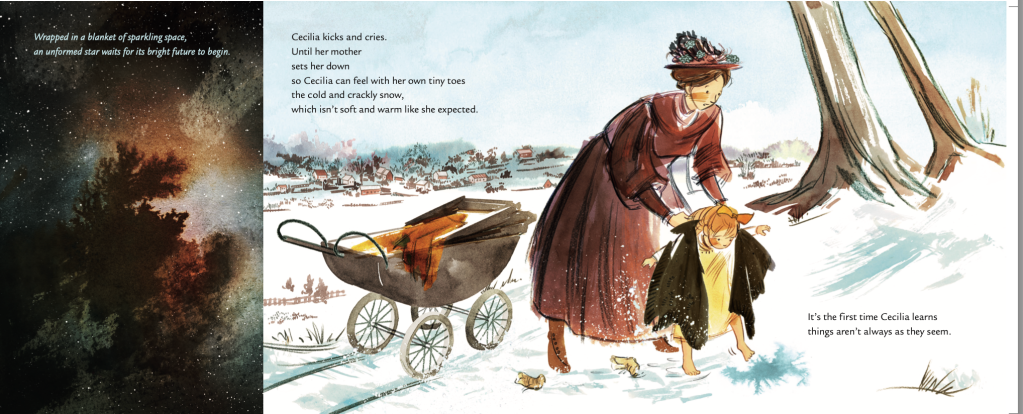THE FIRE OF STARS, written by me, illustrated by Katherine Roy (Chronicle Books) releases in just 18 days, and I’m getting excited. It’s hard to believe it’s been 8 and a half years since I wrote my first draft of this (now) lyrical nonfiction book. It certainly didn’t start out that way.
Here’s the opening of the book, which I’ve transcribed below:

–THE FIRE OF STARS
Wrapped in a blanket of sparkling space,
an unformed star waits for its bright future to begin.
Cecilia kicks and cries.
Until her mother
sets her down
so Cecilia can feel with her own tiny toes
the cold and crackly snow,
which isn’t soft and warm like she expected.
It’s the first time Cecilia learns things aren’t always as they seem.
An earlier draft my agent saw read much differently. Here it is:
“[Cecilia] was full of surprises and driven by a curiosity as wide as the universe. Young Cecilia spent hours outside watching slimy slugs slink through her garden, picking out constellations in the night sky, and counting trees among her best friends.”
What changed? Aside from starting with one, concrete scene, I learned to write lyrically thanks to Renee LaTulippe’s Lyrical Language Lab. That class was transformative for my writing, and today I want to focus on one thing I learned in that class, the use of sound devices. Sound devices add musicality to our writing, helping us set a specific mood.
Sound Devices
Renee discusses sound devices in this video on her Lyrical Language Lab YouTube channel. Some of the elements she covers include:
- alliteration
- assonance
- consonance
- rhyme
Let’s look at each sound device in turn with examples to see how it adds to the lyrical voice I’ve chosen.
Alliteration
Alliteration is when words that are close together start with the same letter or sound. For example, “Wrapped in a blanket of sparkling space,/ an unformed star waits for its bright future to begin./Cecilia kicks and cries.”
In this passage, I’ve started many word with the soft “s” sound, giving the first couple of lines a hushed sound, like a baby sleeping. Then I pivot to a sharp “k” sound for “kicks and cries” and “cold and crackly snow” mimicking the sharp cries of a baby (and the harsh snow). That’s alliteration, and I’ve used it to create a specific effect.
Assonance
This phrases above also have examples of assonance, including bright/cries and own/toes/snow. You might also notice that I picked a lot of long vowel sounds, which add the overall soft/hushed tone of the opening.
Consonance
Consonance is when words close to each other have the same consonant sound anywhere in the words. A good example of this is in the very first line, which is peppered with “p” sounds: “Wrapped in a blanket of sparkling space…” Again, these are soft consonant sounds adding to quiet mood of snow-covered stillness and of wonder.
Rhyme
In prose picture books, we don’t usually use end rhyme, but we can use internal rhyme. Internal rhyme is when words in the middle of a line rhyme. Later in the book, I have a line that reads :”Cecilia is forced to say hello to city streets full of strangers/ and good-bye to the company of trees and bees.” Trees rhymes with bees, a good example of internal rhyme.
Your Turn
Ready to apply some of these sound devices to your own work?
Think about your draft and the mood you are trying to create. Is it quiet and soothing filled with soft consonants and long vowel sounds? Or is it active and playful, with hard consonants and short vowels?
Once you’ve decided your approach, you can use tools like Thesaurus.com (for help with alliteration and consonance) and Rhymezone.com (for assonance and internal rhyme). How could you transform a sentence like “The kite flies through the air?” using the thesaurus and Rhymezone?
You could try, “The kite glides through the sky” for extra assonance. Or “The kite swoops through the sky” for alliteration. What else can you come up with? Do any of these alter the mood?
Adding musicality isn’t hard. The key with sound devices is not to overdo them. Too much alliteration, for example, can cause the reader to stumble over the words. Always read your work out loud to make sure it’s both clear and musical.
To read THE FIRE OF STARS, ask your library to order a copy or order your own. THE FIRE OF STARS is still available for preorder wherever books are sold! You can buy signed copies (with a preorder bonus postcard) through Once Upon a Time (scroll down my FIRE OF STARS page for the link.)



What a great and very helpful post, Kirsten! So nicely explained. And you have made want to read your new book even more! 😊
Thanks for stopping by! And happy reading. Won’t be long now.
8 days… 😊